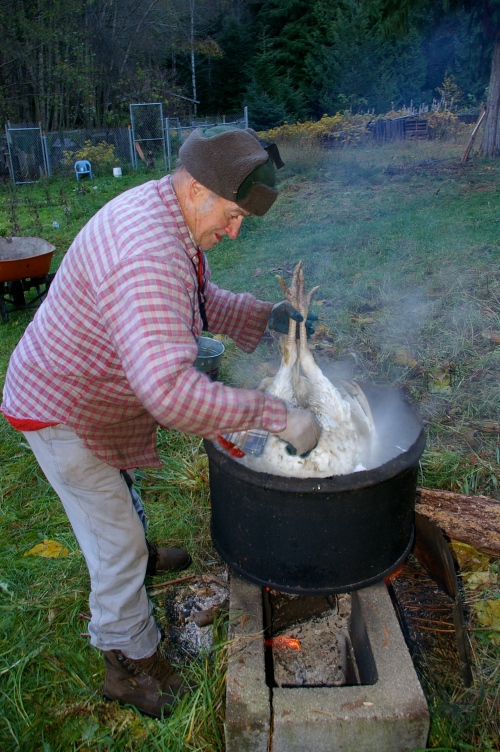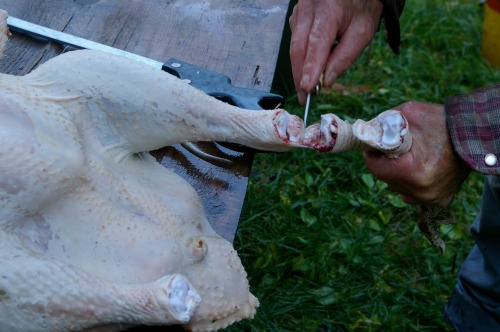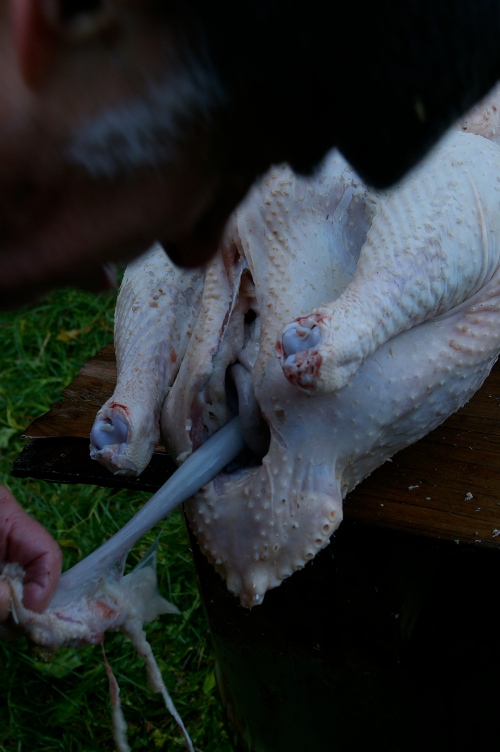This post is at special request of Jo at Little Ffarm Dairy.

Chicken canned and ready for storage and winter use in soups, stews, and my favourite, curries!
This past week and weekend, I completed a marathon butchering fest. In total, I butchered 27 chickens, 2 ducks and 4 turkeys which may not sound like much, but when you are doing it solo and without the aid of any modern day technology, it is a feat, to say the least.
In the midst of it all I also canned 8 chickens, all the stewing beef from our butchered cow, and am presently in the process of cooking two more turkeys and will can them later today. Having taken in the half a cow, I now have no room left in my freezer, so can I must! Food preservation is a juggling act at all times here, as we do not have much room in our wee house and we don’t have any form of cold storage… yet.
The following information includes recipes and methods for SAFE canning of meat, game and poultry which I have collected over the past few years:
Pressure canning is the ONLY SAFE METHOD for canning meat and poultry
Home food preservation must be done with care, to protect the quality and safety of the food. Jars or cans containing low-acid foods–such as vegetables, meats, poultry and seafood–must always be processed under pressure, to prevent spoilage or food poisoning. The bacteria which cause botulism, a severe and potentially fatal from of food poisoning, are not killed by using the hot water bath canning process.
PRESSURE CANNING MEAT (Beef)
All meat should be handled carefully, should be correctly slaughtered, and canned promptly or kept under refrigeration until processed. Keep meat as cool as possible during preparation for canning, handle rapidly, and process meat as soon as it is packed. Most meats need only be wiped with a damp cloth, though I make a habit of rinsing it in cold water (but that is just personal preference).
Use lean meat for canning: remove most of the fat, cut off gristle and remove large bones, and cut into pieces in a convenient size for canning. Pack hot meat loosely, leaving 1-inch head-space in Mason jars.
Prepare broth for filling jars: place bony pieces in saucepan, cover with cold water, and simmer until meat is tender. Cool liquid and discard the layer of fat that hardens on the surface. Bring liquid to a boil and use it to pack into jars packed with precooked meat (and poultry).
NOTE: Meat should not be browned with flour nor should flour be used in the broth to make gravy for pouring over the packed meat as the starch in the flour makes the sterilization process very difficult, and so this is not recommended for home canners. (Best leave this to Chef Boyardee and Heinz.)
Meats may be processed with or without salt. If salt is desired, use only pure canning or pickling salt (table salt contains a filler which may cause cloudiness in bottom of jar). I use 1/2 teaspoon salt to each pint, 1 teaspoon to each quart. More or less salt may be added to suit individual taste.
Follow step-by-step directions for your pressure canner. Process meats according to the following recipes.
When canning food in regions less than 2,000 feet altitude (dial gauge canner) or 1,000 feet altitude (weighted gauge canner), process according to specific recipe. When canning food in regions above 2,000 feet altitude (dial gauge canner) or 1,000 feet altitude (weighted gauge canner), process according to the following chart.
ALTITUDE CHART FOR CANNING MEAT AND POULTRY
| ALTITUDE |
DIAL GAUGE CANNER
Pints and Quarts |
WEIGHTED GAUGE CANNER
Pints and Quarts |
| 1,001 – 2,000 ft. |
11 lbs. |
15 lbs. |
| 2,001 – 4,000 ft. |
12 lbs. |
15 lbs. |
| 4,001 – 6,000 ft. |
13 lbs. |
15 lbs. |
| 6,001 – 8,000 ft. |
14 lbs. |
15 lbs. |
Processing time is the same at all altitudes.
PRESSURE CANNING GAME MEAT
Pressure canning is the ONLY SAFE METHOD for canning meat.
Follow step-by-step directions for your pressure canner. Process your game meat according to the following recipes.
CUT-UP MEAT (strips, cubes, or chunks) Bear, Beef, Pork, Lamb, Veal, and Venison
Remove excess fat. Soak strong-flavored wild meats for 1 hour in brine water containing 1 tablespoon of salt per quart of water. Rinse. Remove large bones and cut into desired pieces.
Raw Pack—Fill jars with raw meat pieces, leaving 1-inch head-space. DO NOT ADD LIQUID. Adjust jar lids.
Hot Pack—Precook meat until rare by broiling, boiling, or frying. Pack hot meat loosely in clean, hot Mason jars, leaving 1-inch head-space. Cover meat with boiling broth, water, or tomato juice (especially with wild game), leaving 1-inch head-space. Adjust jar lids.
Dial Gauge Canner—Process at 11 pounds pressure – Pints 75 minutes and Quarts 90 minutes. For processing above 2,000 feet altitude, see chart for recommended pounds of pressure.
Weighted Gauge Canner—Process at 10 pounds pressure – Pints 75 minutes and Quarts 90 minutes. For processing above 1,000 feet altitude, see chart for recommended pounds of pressure.
PRESSURE CANNING POULTRY
Pressure canning is the ONLY SAFE METHOD for canning poultry.
Follow step-by-step directions for your pressure canner. Process poultry according to the following recipes.
CUT-UP POULTRY
Boil, steam, or bake poultry slowly to medium done. I tend to boil it and make the broth at the same time. If you have broth on hand you can precook in the concentrated broth for more flavor. Poultry is medium done when the pink color in the center is almost gone.
Cut poultry into serving size pieces and if desired, remove bones. I always debone the meat as it is my personal preference. I find it easier to use in recipes if it is done this way. Pack hot poultry loosely in clean, hot Mason jars, leaving 1 1/4-inch head-space.
Make broth from bones and bony pieces, neck, back, and wing tips and the gizzard, heart and liver if you have them. Pack hot meat in clean, hot Mason jars, leaving 1-inch head-space. Do not pack food tightly. Cover poultry with boiling broth or water, leaving 1 1/4-inch head-space. Adjust jar lids.
Poultry may be processed with or without salt. If salt is desired, use only pure canning or pickling salt. Table salt contains a filler which may cause cloudiness in bottom of jar. I use 1/2 teaspoon salt to each pint, 1 teaspoon to each quart.
Dial Gauge Canner—Process at 11 pounds pressure.
With Bone – Pints 65 minutes and Quarts 75 minutes.
Without Bone – Pints 75 minutes and Quarts 90 minutes.
For processing above 2,000 feet altitude, see above chart for recommended pounds of pressure.
Weighted Gauge Canner—Process at 10 pounds pressure.
With Bone – Pints 65 minutes and Quarts for 75 minutes.
Without Bone – Pints 75 minutes and Quarts for 90 minutes.
For processing above 1,000 feet altitude, see above chart for recommended pounds of pressure.
RABBIT
Pressure canning is the ONLY SAFE METHOD for canning rabbit.
Follow step-by-step directions for your pressure canner. Process rabbit according to the following recipes.
Soak dressed rabbits 1 hour in water containing 1 tablespoon of salt per quart. Rinse and remove excess fat. Cut into serving size pieces. Boil, steam, or bake to medium done. Rabbit is medium done when pink color in center is almost gone. Pack hot rabbit loosely in clean, hot Mason jars, leaving 1 1/4-inch head-space. Cover rabbit with boiling broth or water leaving 1 1/4-inch head-space and adjust jar lids.
Dial Gauge Canner—Process at 11 pounds pressure.
With Bone – Pints 65 minutes and Quarts for 75 minutes.
Without Bone – Pints 75 minutes and Quarts for 90 minutes.
For processing above 2,000 feet altitude, see chart for recommended pounds of pressure.
Weighted Gauge Canner—Process at 10 pounds pressure.
With Bone – Pints 65 minutes and Quarts for 75 minutes.
Without Bone – Pints 75 minutes and Quarts for 90 minutes.
For processing above 1,000 feet altitude, see chart for recommended pounds of pressure.














































